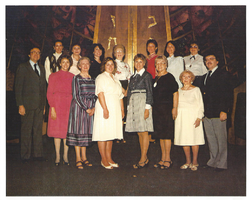Search the Special Collections and Archives Portal
Search Results
Valerie Wiener oral history interview
Identifier
Abstract
Oral history interview with Valerie Wiener conducted by Barbara Tabach on January 20, 2015 for the Southern Nevada Jewish Heritage Project. In this interview, Wiener discusses her childhood and being raised in Las Vegas, Nevada in the 1950s as well as the academic path that led her career into politics. Throughout Wiener’s interview, she highlights the traditions of the small, but growing Las Vegas Jewish population in the 1960s. Wiener also discusses her community service work and her life mantra of giving.
Archival Collection
Elaine Galatz oral history interview
Identifier
Abstract
Oral history interview with Elaine Galatz conducted by Barbara Tabach on April 22, 2015 for the Southern Nevada Jewish Heritage Project. Galatz discusses her work as a past Jewish Federation president, her marriage to renowned attorney Neil Galatz, and her career as an accomplished horsewoman.
Archival Collection

Transcript of interview with Elmer Hilsinger by Irene Rostine, October 2, 1991
Date
Archival Collection
Description
When Mr. Elmer Hilsinger arrived from the Los Angeles area in 1942, to work as a Refractory Inspector in the Engineering Department at Basic Magnesium Incorporated (BMI), little did he know the town site would grow to be known as Henderson, Nevadain a few short decades. Mr. Hilsinger’s oral history provides a glimpse of the work being done by women at BMI, including women working as chemists, truck drivers, and secretaries. His words attest to the strong work ethic demonstrated by women at the plant during the “war work” period. Through Mr. Hilsinger’s story, we are also provided with an account of what daily life was like for a married couple, including Mr. Hilsinger’s life with his wife who worked as a waitress at Anderson Camp. In addition, Mr. Hilsinger’s oral history touches on the evolution of safety rules within the plant, the transition from the American Federation of Labor Union to the Congress of Industrial Organizations Union, and the role prostitution played during the tim
Text
Suzie Chenin oral history interview
Identifier
Abstract
Oral history interview with Suzie Chenin conducted by Barbara Tabach on September 29, 2015 for the Southern Nevada Jewish Heritage Project. Chenin discusses her father, one of the first Jewish dentists in Las Vegas, Nevada, and moving there when he was stationed at the Nellis Air Force Base. Chenin also talks about her career as a real estate agent and selling advertising for the Las Vegas Sun newspaper.
Archival Collection

Transcript of interview with Hershel Brooks by Barbara Tabach, December 8, 2016
Date
Archival Collection
Description
Hershel Brooks was born December 3, 1930 in Brooklyn, New York. He was raised in an orthodox Jewish household, along with his four siblings, and attended Jewish community schools before pursuing his rabbinical studies. He studied at TelsheYeshiva in Cleveland, Torah Vodaath in New York, and Jewish Theological Seminary in New York. Before assuming his first rabbinical position, Brooks married his wife, Alma, and graduated with his BA from the University of Miami. He was first hired by a conservative congregation in Miami, and subsequently led congregations in Savannah, Georgia, Greensboro, North Carolina and Philadelphia, Pennsylvania. Eventually, he joined a temple in Anaheim, California, where he served for twenty years. In 1996, Brooks retired to Las Vegas. He was soon asked to lead services at Temple Bet Knesset Bamidbar [BKB] twice a month as its rabbi. He still is active at BKB, though he retired in 2011. In this interview, Brooks reflects on his family background and the path that lead to his becoming a rabbi in the Conservative Jewish Movement. He talks about his career, including his involvement with BKB as well as other Jewish community service, including facilitating adult bar mitzvah classes and serving on the local Rabbinical court of Judaism, known as Bet Din.
Text

Photograph of Sharon Sigesmund Pierce at her bat Mitzvah as an adult, March 16, 1984
Date
Archival Collection
Description
Photograph of group of women at their bat Mitzvah, including Sharon Sigesmund Pierce (front, center-right), and her mother Sara Schwartz (front row, third from right), at Temple Beth Sholom.
Image
Beth Molasky oral history interview
Identifier
Abstract
Oral history interview with Beth Molasky conducted by David Schwartz on June 06, 2014 for the Southern Nevada Jewish Heritage Project. Molasky discusses her childhood experiences in Las Vegas, Nevada, especially as a member of the Jewish community. She also reflects on changes that influenced her children’s upbringing in the city.
Archival Collection

Transcript of interview with Stella Butterfield by Joanne Goodwin, October 14 & October 25, 2005
Date
Archival Collection
Description
Interviewed by Joanne L. Goodwin. Stella Butterfield's family, the Goldbergs, was Jewish, and she was born in the Bronx. During World War II she worked for the Coast Guard in the steno pool in Washington, D.C. Stella moved to Santa Monica a few years later while the war was still going on and worked briefly as a riveter for Douglas Aircraft and then as a teletype operator for the Air Force but at Douglas Aircraft. Because she had a hard time getting a job because of antisemitism, she changed her name to Gilbert. In December of 1948 she went to the Canal Zone in Panama to be the secretary of the commanding officer of the Panama Supply Depot. Stella was also a law reporter for court martials. She met Frank Butterfield, who was stationed there, and married him in 1952. He was transferred back to the United States, and they lived in Massachusetts. Then they moved to Los Angeles, and in 1953 they moved to Las Vegas, where she was a court reporter at Nellis Air Force Base. Then they moved to Mexico City, then back to California where she worked as a legal secretary. In early 1955 they moved back to Las Vegas, and Stella worked as a federal court reporter for Judge Roger T. Foley.
Text
Congregation Ner Tamid member and event photographs, annual reports, "Mensch of the Year" award, "Women of Valor" award, Congregation Ner Tamid booklets, confirmation services programs, gala programs and invitations, CNT temple exterior photographs, 2006 to 2018
Level of Description
Archival Collection
Collection Name: Congregation Ner Tamid Records
Box/Folder: Box 03, Digital File 00, Box SH-051
Archival Component

